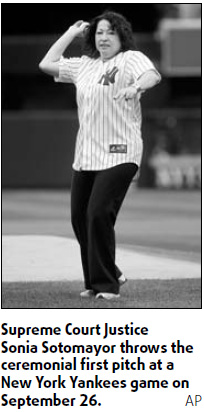New justice, new term at US Supreme Court
WASHINGTON: Justice David Souter never danced the salsa in public. Justice John Paul Stevens doesn't sing in karaoke bars. And Chief Justice John Roberts hasn't thrown out the first pitch at Yankee Stadium.
But that was yesterday's US Supreme Court. The newest justice, Sonia Sotomayor, has done all three of those things - in the less than two months since she replaced Souter on the court.
While the Supreme Court is all about the law, personalities matter. As the court began its new term this week, the justices will be dealing not only with the cases in front of them but with a wild card: how Sotomayor and her effervescence may change things.
"It's like when you were little and a new kid joined the class," said Stephen Wermiel, a constitutional law professor at American University. "There was always a little air of excitement or anticipation because you didn't know how it would change the dynamic."

The earliest indications are that she is unlikely to affect the outcome or alter the terms of debate in two of the high-profile cases that probably will dominate the term: a challenge to limits on corporate spending in political campaigns and a lawsuit seeking to strike down local handgun bans in the Chicago area.
In both cases, conservative majorities that prevailed in earlier cases appear solid. Sotomayor probably will side with the court's liberals in dissent from decisions in favor of gun rights and loosening campaign finance restrictions, as the now-retired Souter did.
The justices say any change in the court matters.
"It's a new court. When I was trying jury cases, which is usually 12, if a juror had to be replaced because one was ill or something ... it's just a different dynamic. It was a different jury. And it's the same way here. This will be a very different court," Justice Anthony Kennedy has said.
Sotomayor is the third new justice on the court since 2005, when Roberts was confirmed as the first of President George W. Bush's two nominees. Justice Samuel Alito came on board early in 2006.
Indications are that more change in the makeup of the court could come soon. Justice John Paul Stevens, who turns 90 in April, acknowledged last month that he has so far hired fewer law clerks than usual for next year, a move widely considered to be a signal that he is at least contemplating retiring.
Justice Ruth Bader Ginsburg, 76, appears well after her surgery for pancreatic cancer in February and has said she plans to serve into her early 80s. But the long-term prognosis for pancreatic cancer is poor.
The retirement of either justice would give President Barack Obama, who named Sotomayor, another nominee, although the ideological balance of the court probably would not change. For that to happen, one of the conservatives would have to leave during Obama's presidency. None of the current conservative justice has even hinted at retirement.
Deanne Maynard, a Supreme Court advocate at the Morrison and Foerster law firm and a former high court law clerk, said any short list of prospective nominees would include women. "It's very intriguing, to me at least, that there'd be three women on the court," Maynard said.
AP
(China Daily 10/08/2009 page8)














